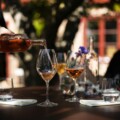Fil Bucchino is too smart to answer my question directly. I’ve asked the olive oil expert how much I should spend when I buy a bottle of extra virgin, and the question is a bit of a trap. There’s no real answer. So, I suggest a number in an indirect way.
“How about $50? That seems like a lot of money to spend open a bottle of oil.”
Bucchino smiles and makes a comparison he knows I will understand: “Let’s say you spend $50 on a good bottle of wine, you take it home and enjoy it with your partner or friends over dinner. You’ve had a great experience for one night. But if you pay $50 for a good bottle of extra virgin olive oil, and use it every day to improve your meals, you’ll have enjoyment for a whole month.”
Bucchino is the principal and force behind Abandoned Grove, which makes olive oil in Tuscany from trees they have rehabilitated and brought back to productive life. The company is a little different. It doesn’t sell bottles of olive oil so much as it sells the rescued tree from which it is made.
It may be fair to say that Bucchino, fit and boyish looking despite middle age, might be a little different too. He describes himself as Florence-born, Toronto-raised. His first career was as a punk rock musician, and it was on a tour break in Tuscany two decades ago that he tried a life-changing olive oil and re-channelled that punk energy into a dedication to spreading the word about EVOO.
When Bucchino isn’t rehabilitating abandoned olive groves, leading tastings, judging competitions, or making the 2017 documentary about his work, Obsessed With Olive Oil, he’s educating the public and restaurant trade about high-quality olive oil. When I met with him recently in Toronto, to discuss Abandoned Grove’s next harvest, he impressed upon me an important fact: olive oil is essentially just olive juice.
Like any fresh-squeezed juice, and in contrast to age-worthy wine, it’s never better than the day the olives were pressed into oil. According to Bucchino, focusing on price, or even brand, obscures the most important information on the bottle: the date it was harvested.
“Any producer who actually cares writes the harvest date on the bottle,” he says emphatically. If there’s no date on the bottle, that’s a big red flag for Bucchino. He compares the experience of an older olive oil to turning the volume down on a stereo. The information might still be there, but there is less of it.
Bucchino suggests using older oils, from harvests more than a year old, for frying. He also notes that storing olive oil in a cool dark place (i.e. not next to the stove) will extend its life. And more robust oils have more flavour-producing polyphenols, which also guard against and slow down oxidization.
Storing bottles next to stoves, where heat and light can damage them, is a real bugbear for Bucchino: “I have this conversation with chefs all the time, where they take care of every single ingredient and put them together so meticulously…and then you grab the bottle of oil that’s been sitting next to the heat of the stove and you pour it on,” he says shaking his head.
It gets worse. Not only does the clock start ticking from the moment the olives are harvested, but another shorter clock begins a countdown the moment the cap from a bottle is removed: “Once you open a bottle, you have four to six weeks.” For this reason, Bucchino says he rarely has more than two oils open in his kitchen at a time, so they can be used up quickly while they retain as much of their flavour as possible. As he says, “If you’re paying for it, you want to taste it.”
Speaking of tasting, Bucchino has brought a bottle of oil from his Abandoned Grove project. It’s the top-end oil, taken from the best sites, all of which are near Florence, to the south of the city. Bucchino explains that Abandoned Groves now has about five thousand trees under their care. I am amazed to learn that a mature olive tree will produce enough olives to make about a litre of oil a year. That’s it.

Fil Bucchino tasting some Abandoned Grove olive oil. Credit: Fil Bucchino.
Abandoned Grove works a bit like a club, and membership, which costs $175, means assuming responsibility for a tree. And yes, they track every member to every tree, so, if you join you can go to Tuscany and visit “your tree.” One 500-millilitre bottle of oil from each year’s harvest goes to the member, and one stays in the community.
And it’s not just the trees that are rehabilitated, the organization actively recruits people who might otherwise have trouble finding work, like recovering addicts or ex-convicts.
Bucchino pours his oil, from last year’s harvest, into two small blue vessels for us to taste it. They look like a cross between a shot glass and the bowl of a wine glass. They are coloured dark blue so we can’t see the colour of the oil, which might falsely suggest flavour.
Then he starts rubbing the glass, explaining that the oil is a little cold and he’s heating it with the body temperature of his hands. “The ideal tasting temperature,” he says, “is 27 degrees.”
Once the oil is warmed up a bit he leads me through the tasting process. We are looking for three basic characteristics. First on the nose, the fruit. There is a lot going on here. Definitely a bold and grassy character but some rounder notes too. At first, I can’t place it, but when Bucchino suggests almond I recognize it.
“One way I know I really like an oil,” he says, “is how long I want to just smell it.”
Second, as the oil enters our mouths, we are discerning its bitterness. The oil is unctuous, rich, and heavy on the palate. Like acidity in wine, the alkaline bitterness of the olive is what holds everything together and keeps it from being cloying.
Bucchino shows me how to pull air into my mouth, explaining that this will have the twin effects of mixing the oil with my saliva and releasing volatile phenolic molecules up into the back of my nose, where I will discern more elements of flavour and the third important characteristic of the oil: spiciness.
Pepper notes hit the back of my throat as soon as the oil has entered my mouth and rise to a crescendo as I begin to swallow. They are bold but not debilitating; there’s no coughing or crying. They feel good, as though they manifest the antioxidant virtues of the oil itself.
It’s delicious, and I go for a second taste.









